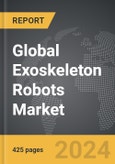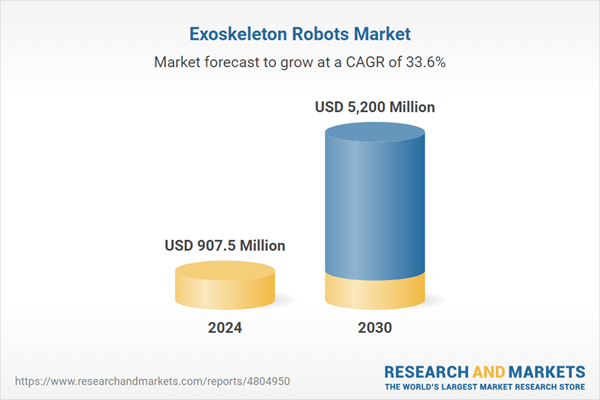The global market for Exoskeleton Robots was valued at US$907.5 Million in 2024 and is projected to reach US$5.2 Billion by 2030, growing at a CAGR of 33.6% from 2024 to 2030. This comprehensive report provides an in-depth analysis of market trends, drivers, and forecasts, helping you make informed business decisions.
The design and functionality of exoskeleton robots have evolved significantly with technological progress. Early models were cumbersome and limited in functionality, but recent innovations have led to more lightweight, flexible, and user-friendly designs. Modern exoskeletons are equipped with sensors and actuators that detect and respond to the user's movements, providing precise assistance and ensuring natural motion. Advances in battery technology have also extended the operational time of these devices, making them more practical for everyday use. Integration with artificial intelligence and machine learning allows exoskeletons to adapt to the specific needs of the user, improving their effectiveness in both therapeutic and functional applications. These improvements have expanded the potential of exoskeleton robots, making them more accessible and beneficial for a broader range of users.
The growth in the exoskeleton robots market is driven by several factors, reflecting the increasing demand and technological advancements in various sectors. One significant driver is the aging global population, which boosts the need for mobility aids and rehabilitation devices to improve the quality of life for the elderly and disabled. The industrial sector's focus on worker safety and productivity is another critical factor, as exoskeletons help reduce workplace injuries and enhance efficiency. Military and defense applications continue to drive innovation and investment in exoskeleton technology, with governments and organizations seeking to improve soldier performance and capabilities. Additionally, the rapid advancements in robotics, AI, and materials science have made exoskeletons more affordable, efficient, and versatile, further propelling market growth. The increasing number of regulatory approvals and positive clinical outcomes also bolster market confidence and adoption. These factors collectively ensure the robust expansion and continued evolution of the exoskeleton robots market, promising significant advancements in human augmentation and assistive technologies.
Global Exoskeleton Robots Market - Key Trends & Drivers Summarized
Exoskeleton robots, also known as exosuits or wearable robots, represent a significant technological advancement in augmenting human capabilities. These wearable devices are designed to enhance the strength, endurance, and mobility of the user by providing mechanical assistance through an external framework. Exoskeleton robots find applications in various fields, including healthcare, industrial work, military, and rehabilitation. In healthcare, they are used to aid individuals with mobility impairments, offering a means to regain movement and independence. In industrial settings, exoskeletons help workers perform physically demanding tasks by reducing strain and preventing injuries. Military applications include enhancing soldier performance by allowing them to carry heavier loads and move more efficiently in combat environments. The development and deployment of exoskeleton robots are driven by advancements in robotics, materials science, and artificial intelligence.The design and functionality of exoskeleton robots have evolved significantly with technological progress. Early models were cumbersome and limited in functionality, but recent innovations have led to more lightweight, flexible, and user-friendly designs. Modern exoskeletons are equipped with sensors and actuators that detect and respond to the user's movements, providing precise assistance and ensuring natural motion. Advances in battery technology have also extended the operational time of these devices, making them more practical for everyday use. Integration with artificial intelligence and machine learning allows exoskeletons to adapt to the specific needs of the user, improving their effectiveness in both therapeutic and functional applications. These improvements have expanded the potential of exoskeleton robots, making them more accessible and beneficial for a broader range of users.
The growth in the exoskeleton robots market is driven by several factors, reflecting the increasing demand and technological advancements in various sectors. One significant driver is the aging global population, which boosts the need for mobility aids and rehabilitation devices to improve the quality of life for the elderly and disabled. The industrial sector's focus on worker safety and productivity is another critical factor, as exoskeletons help reduce workplace injuries and enhance efficiency. Military and defense applications continue to drive innovation and investment in exoskeleton technology, with governments and organizations seeking to improve soldier performance and capabilities. Additionally, the rapid advancements in robotics, AI, and materials science have made exoskeletons more affordable, efficient, and versatile, further propelling market growth. The increasing number of regulatory approvals and positive clinical outcomes also bolster market confidence and adoption. These factors collectively ensure the robust expansion and continued evolution of the exoskeleton robots market, promising significant advancements in human augmentation and assistive technologies.
Scope of the Study
The report analyzes the Exoskeleton Robots market, presented in terms of market value (US$ Thousand). The analysis covers the key segments and geographic regions outlined below.Segments:
Component (Hardware, Software); Type (Mobile, Fixed / Stationary); Extremity (Lower Body, Upper Body, Full Body); End-Use (Healthcare, Military & Defense, Other End-Uses).Geographic Regions/Countries:
World; United States; Canada; Japan; China; Europe (France; Germany; Italy; United Kingdom; and Rest of Europe); Asia-Pacific; Rest of World.Key Insights:
- Market Growth: Understand the significant growth trajectory of the Exoskeleton Robot Hardware segment, which is expected to reach US$3.6 Billion by 2030 with a CAGR of a 31.4%. The Exoskeleton Robot Software segment is also set to grow at 40.1% CAGR over the analysis period.
- Regional Analysis: Gain insights into the U.S. market, valued at $336.9 Million in 2024, and China, forecasted to grow at an impressive 41.5% CAGR to reach $783.0 Million by 2030. Discover growth trends in other key regions, including Japan, Canada, Germany, and the Asia-Pacific.
Report Features:
- Comprehensive Market Data: Independent analysis of annual sales and market forecasts in US$ Million from 2024 to 2030.
- In-Depth Regional Analysis: Detailed insights into key markets, including the U.S., China, Japan, Canada, Europe, Asia-Pacific, Latin America, Middle East, and Africa.
- Company Profiles: Coverage of major players such as Bionik Laboratories Corp., Bioservo Technologies AB, B-Temia Inc., Cyberdyne Inc., Ekso Bionics Holdings Inc. and more.
- Complimentary Updates: Receive free report updates for one year to keep you informed of the latest market developments.
Why You Should Buy This Report:
- Detailed Market Analysis: Access a thorough analysis of the Global Exoskeleton Robots Market, covering all major geographic regions and market segments.
- Competitive Insights: Get an overview of the competitive landscape, including the market presence of major players across different geographies.
- Future Trends and Drivers: Understand the key trends and drivers shaping the future of the Global Exoskeleton Robots Market.
- Actionable Insights: Benefit from actionable insights that can help you identify new revenue opportunities and make strategic business decisions.
Key Questions Answered:
- How is the Global Exoskeleton Robots Market expected to evolve by 2030?
- What are the main drivers and restraints affecting the market?
- Which market segments will grow the most over the forecast period?
- How will market shares for different regions and segments change by 2030?
- Who are the leading players in the market, and what are their prospects?
Some of the 100 major companies featured in this Exoskeleton Robots market report include:
- Bionik Laboratories Corp.
- Bioservo Technologies AB
- B-Temia Inc.
- Cyberdyne Inc.
- Ekso Bionics Holdings Inc.
- Gogoa Mobility Robots (Spain)
- Hocoma AG
- Lockheed Martin Corporation
- Ottobock SE & Co. KGaA
- RB3D
- Rehab-Robotics Company Limited
- ReWalk Robotics Ltd.
- Rex Bionics Ltd.
Table of Contents
I. METHODOLOGYMII. EXECUTIVE SUMMARY2. FOCUS ON SELECT PLAYERSIII. MARKET ANALYSISCANADAITALYREST OF EUROPEREST OF WORLDIV. COMPETITION
1. MARKET OVERVIEW
3. MARKET TRENDS & DRIVERS
4. GLOBAL MARKET PERSPECTIVE
UNITED STATES
JAPAN
CHINA
EUROPE
FRANCE
GERMANY
UNITED KINGDOM
ASIA-PACIFIC
Companies Mentioned (Partial List)
A selection of companies mentioned in this report includes, but is not limited to:
- Bionik Laboratories Corp.
- Bioservo Technologies AB
- B-Temia Inc.
- Cyberdyne Inc.
- Ekso Bionics Holdings Inc.
- Gogoa Mobility Robots (Spain)
- Hocoma AG
- Lockheed Martin Corporation
- Ottobock SE & Co. KGaA
- RB3D
- Rehab-Robotics Company Limited
- ReWalk Robotics Ltd.
- Rex Bionics Ltd.
Table Information
| Report Attribute | Details |
|---|---|
| No. of Pages | 425 |
| Published | February 2025 |
| Forecast Period | 2024 - 2030 |
| Estimated Market Value ( USD | $ 907.5 Million |
| Forecasted Market Value ( USD | $ 5200 Million |
| Compound Annual Growth Rate | 33.6% |
| Regions Covered | Global |









